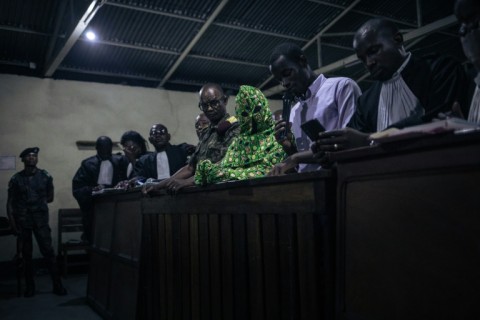KINSHASA - Two weeks into a military trial over the killing of more than 50 civilians in eastern DR Congo, the circumstances of how soldiers came to open fire are still unclear.
Who gave the order, at what point and why did Congolese soldiers shoot to prevent an anti-UN protest in the city of Goma are key but as yet unanswered questions.
Witnesses -- some taking the stand with their faces masked by cagoules to hide their identity -- have cast doubt on the official version of events.
In a region long plagued by violence in the volatile east of the Democratic Republic of Congo, the incident has raised tensions.
On August 30, soldiers stopped a religious sect from holding a demonstration against the presence of United Nations peacekeepers in the DRC.
At least 57 people were killed, according to Interior Minister Peter Kazadi.
Less than a week after the crackdown, six soldiers including two officers of the elite Republican Guard went on trial charged with crimes against humanity and violating orders.
Several ministers visited the scene of the killings while the government has promised that justice will be done.
- Contradictory -
Kazadi, among others, has said the Republican Guard intervened after the lynching of a police officer by members of the religious sect.
Witnesses -- including two army colonels but also sect members and local residents -- however say the operation began before the police officer died.

At least five people were killed in the religious sect's radio premises, but most died in its church, according to witness testimony.
At the time that soldiers were heading towards the church, "the police officer was not yet dead", a military intelligence officer told the court.
A few days after giving his testimony, the witness was in hospital due to a "poisoning", the court heard.
- M23 rebels -
On one point, however, everyone agrees.

Before the shooting began, talks between the army and the sect were under way and progressing calmly.
Four people had been chosen to be the emissaries of a message to be delivered to the UN mission.
In the middle of the negotiations however, soldiers opened fire on unarmed sect members.
It remains to be established whether Mike Mikombe, one of the accused Republican Guard officers who has denied the charges, gave the order to shoot.
And, if he did, whether he was following orders or acted on his own initiative.
He suggested in court that he had been misled by an operational order identifying the sect members as proxies of M23 rebels and the Rwandan army.
The M23 has captured swathes of territory in North Kivu province since 2021 -- one of several militias holding sway over much of the region despite the presence of peacekeepers.
Independent UN experts, the Kinshasa government and several Western nations including the United States and France accuse Rwanda of actively backing the Tutsi-led M23 -- claims that Rwanda denies.
- Arrests, burials -
More than 140 civilians including around 30 minors were arrested during the August 30 army operation.
They were accused of participation in an insurrectional movement, conspiracy and murder.
According to one mother, who is still trying to see her 17-year-old son being held in Goma prison, soldiers took him from his home, accusing him of being a rebel.
She has begged authorities to free him so he can go back to school.
The treatment of the victims has also sparked tension.
Families were only able to bury the dead late on Monday after the bodies were left decomposing in a Goma military hospital for 20 days.
Relatives were banned from visiting the morgue to identify their loved ones until September 12.
The trial is due to continue on Wednesday after a two-day break.
ah/at/emd/kjm/pvh
By Alexis Huguet

